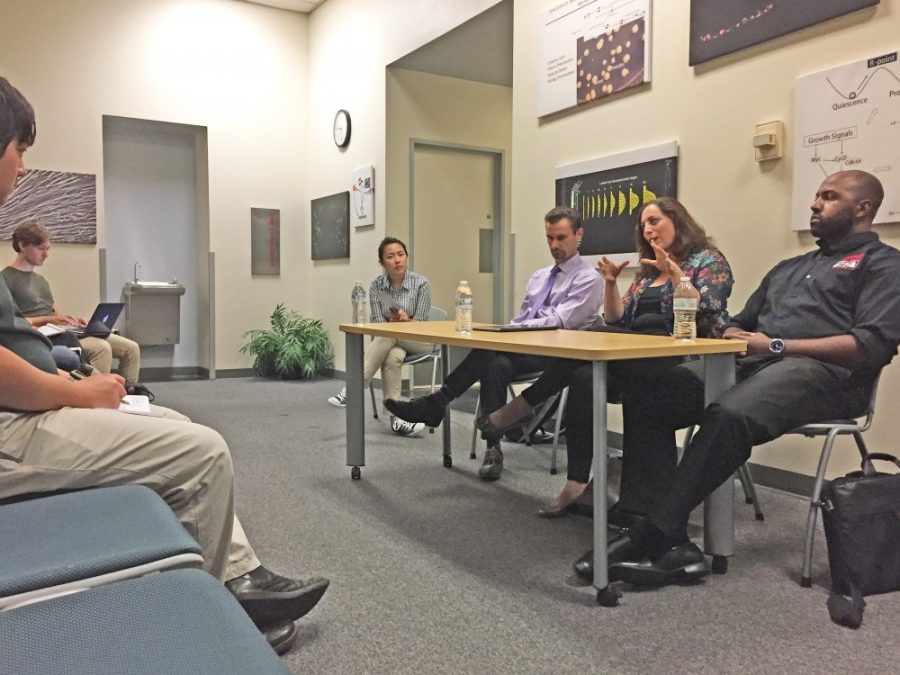The Undergraduate Biological Research Program (UBRP) Ambassadors club hosted a opioid panel in the Life Sciences South Atrium on campus Oct. 17.
The panel was open to the public in order to educate people about research and health care perspectives concerning the current U.S. opioid epidemic.
The panel consisted of University of Arizona faculty Dr. Todd Vanderah, head of the department of pharmacology; Dr. Steven Dudley, in the department of toxicology; and Dr. Katherine Hiller, with the department of emergency medicine.
“This panel is important because it addresses a growing crisis in the United States,” Tiffany Cho, UBRP club president and neuroscience and cognitive science junior, said.
According to the National Institute on Drug Abuse website, regular use of opioids can lead to dependence on the drugs. Misuse of opioid pain relievers can lead to overdose and death.
Opioids are a class of drugs that include the illegal drug heroin, synthetic opioids such as fentanyl and pain relievers available legally by prescription, such as oxycodone, hydrocodone, codeine, morphine and methadone, according to the Centers for Disease Control and Prevention website.
Opioids are narcotics that affect the brain stem and amount of dopamine released in the brain. Many different opioids work at similar receptors in the brain. These receptors will emit dopamine at different rates, which is the body’s reward response, Vanderah said.
According to Vanderah, an average of two Arizonans per day die from narcotic-related causes. “Narcotic” refers to substances that bind at opioid receptors, and they are often combined with other types of drugs.
“You can blame hospitals for over-prescriptions, not just doctors,” Vanderah said. “Hospitals are pressured for getting higher ratings and less complaints from patients that would make their scores lower, making less people [use] their facilities.”
RELATED: The hormones that may be making your dog aggressive
Vanderah said 290 million narcotic prescriptions were written in the U.S. in 2016. He noted that the number could be skewed by some people having multiple prescriptions.
Hiller agreed that hospitals are feeling pressure to get good ratings.
“Every patient comes with an expectation [that] every patient leaves with something,” Hiller said. “A better way to look at satisfaction is looking at what are their expectations, and are they realistic.”
Those expectations are sometimes not based in science, as an example Vanderah gave showed.
“Patient rating systems that say a friend had a similar surgery and [had] more pills given to them, so the patient expects to get the same amount of pills,” Vanderah said.
Opioids aren’t prescribed in other countries as much as in the U.S., according to the a CNBC article, and the used opioid supply is 95 percent larger in the U.S. than in any other country,
“The U.S. has 100 million people suffering from some type of chronic pain,” Vanderah said. “We don’t have much more methods for treatment than just prescribing pills.”
Miguel Pacheco, a biochemistry senior who attended the panel, said that seems to be a U.S.-centric problem.
“Seems like [other] countries aren’t using more holistic methods, just fewer pills [than the U.S.],” Pacheco said.
However, Maggie Kautz, an optical science and engineering junior who also attended the panel, said she thinks a holistic approach is better.
“It astounds me how eager Americans are to get pill pills, because they should focus on more holistic methods,” Kautz said.
Vanderah is currently studying cannabinoids as a replacement painkiller for bone pain with a five-year grant from the Investigational New Drug program.
RELATED: Cannabis and cancer: another connection
“Our research has found if you remove the psychotropic factors, cannabinoids don’t only help with pains, they can rebuild bone as well,” Vanderah said.
Primary-care physicians are the primary prescribers for opioids. One solution, according to Hiller, is to update the prescription drug monitoring program that pharmacies can access, which tells medicine prescribers how much, how often and how long ago the other opioids were prescribed to a patient.
According to Dudley, 27 to 31 states have a collective database of the monitoring program.
“There is no national program yet, but it is becoming more mandatory to check [the monitoring program],” Dudley said.
Hiller said many people are afraid to get help because they don’t want to get in legal trouble.
“There is a lot of societal pressure for [not] calling emergency first-responders in fear of getting in trouble with the police,” Hiller said.
Hiller said that cultural mistrust of medical professionals just makes giving care more difficult.
“My goal in the emergency department isn’t to be mean and deny medication, it’s to make you better,” Hiller said. “We have many rehab places in Tucson and 24-hour social workers in the emergency department.”
Hiller said she’s optimistic for the future, as with better training, current and future doctors and nurse practitioners could make a big difference by not defaulting to opioids.
“We have things that we as prescribers have control over, like writing less prescriptions,” Hiller said.
Follow Olivia Jones on Twitter









